- Home
- Basic Lessons
- Demonstrative Pronouns & Adjectives
Demonstrative Pronouns and
Demonstrative Adjectives -
Free Japanese Lessons: 4
There is an obvious distinction between demonstrative pronouns and demonstrative adjectives in Japanese.
'This' and 'that' in the Japanese language are both examples of the former as well as the latter.
You might have noticed that native Japanese used these three words: これ (kore) それ (sore) and あれ (are) to refer to things or people around them.
These three are the most commonly used demonstrative pronouns in Japanese.
Unlike in the English language where 'this + bag' or 'that + bag' are followed by nouns, demonstrative pronouns in Japanese are not followed by a noun.
There are three demonstrative adjectives in Japanese: この (kono) その (sono) and あの (ano).
Demonstrative adjectives in the Japanese language are followed by a noun, similar to English i.e. this bag, that bag etc.
これ (kore) それ (sore) あれ (are)
The three most commonly used Japanese demonstrative pronouns are これ (kore), それ (sore) and あれ (are).
While in English we identify objects by "this" and "that", Japanese natives identify objects by "this", "that", "that over there".
- これ (kore) refers to an object near to the speaker
- それ (sore) explains an object near to the listener
- あれ (are) dictates an object far from both the speaker and the listener
Everything is in reference from the point of view of the speaker. So the speaker can point to a bag in front of him and say:
- これはわたしのかばんです。
kore wa watashi no kaban desu
Meaning: This is my bag.
The speaker can point to a bag in front of the listener and say:
- それはあなたのかばんです。
sore wa anata no kaban desu
Meaning: That is your bag.
The speaker can then point to a bag far away from both of them and say:
- あれはジョンさんのかばんです。
are wa jon san no kaban desu
Meaning: That (over there) is John's bag.
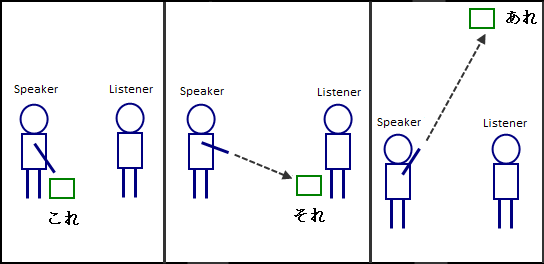 Japanese demonstrative pronouns
Japanese demonstrative pronounsDepending on the situation, sometimes if both the speaker and the listener are close enough, they can consider themselves as one entity.
Therefore they can refer to object near to them as これ (kore), refer to object slightly away from them as それ (sore) and object far away from them as あれ (are).
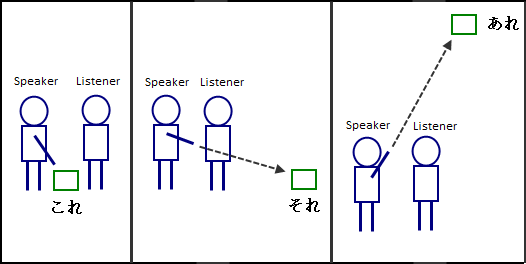 Japanese demonstrative pronouns
Japanese demonstrative pronounsThere is an associated question word どれ (dore) for these demonstrative pronouns.
You can use this to ask question when you want to determine certain object from within a group of similar objects.
- あなたのかばんはどれですか。
anata no kaban wa dore desu ka
Meaning: Which (one of these bags) is you bag?
この (kono) その (sono) あの (ano)
These three Japanese demonstrative adjectives modify nouns that follow after them.
So the formats are always このNoun, そのNoun and あのNoun. They are used to identify objects in a similar way.
- このNoun (kono Noun) refers to an object or person near to the speaker
- そのNoun (sono Noun) refers to an object or person near to the listener
- あのNoun (ano Noun) refers to an object or person far from both the speaker and the listener
Using the same example, the speaker will point to a bag in front of him and say:
- このかばんはわたしのです。
kono kaban wa watashi no desu
Meaning: This bag is mine.
The speaker will point to a bag in front of the listener and say:
- そのかばんはあなたのです。
sono kaban wa anata no desu
Meaning: That bag is yours.
The speaker can then point to a bag far away from both of them and say:
- あのかばんはジョンさんのです。
ano kaban wa jon san no desu
Meaning: That bag over there is John's.
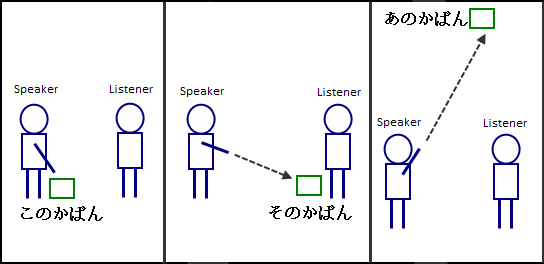 Japanese demonstrative adjectives
Japanese demonstrative adjectivesNotice that when the same noun is repeated in a sentence, it can be omitted, just like the かばん (kaban) in the above examples.
When both the speaker and the listener are close enough, they can consider themselves as one entity and refer to an object/person near to them as このNoun (kono Noun).
They would also refer to an object/person slightly away from them as そのNoun (sono Noun) and an object/person far away from them as あのNoun (ano Noun).
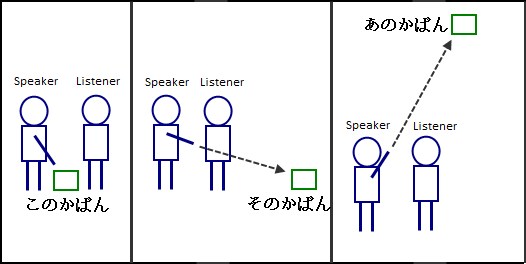 Japanese demonstrative adjectives
Japanese demonstrative adjectivesAnd the associated question word for these demonstrative adjectives is どの (dono).
You can use this to ask question to determine certain object/person from within a group:
- わたしのかばんはどのかばんですか。
watashi no kaban wa dono kaban desu ka
Meaning: Which one is my bag? / Which one of (these bags) is mine?
ここ (koko) そこ (soko) あそこ (asoko)
While これ (kore), それ (sore) and あれ (are) refer to things, another three demonstrative pronouns ここ (koko), そこ (soko) and あそこ (asoko) refer to places.
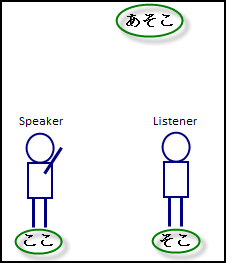 Japanese demonstrative pronouns
Japanese demonstrative pronouns- ここ (koko) refers to the place where the speaker is
- そこ (soko) points to the place where the listener is
- あそこ (asoko) indicates the place which is far from both the speaker and the listener
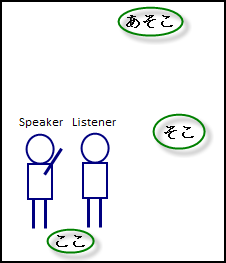 Japanese demonstrative pronouns
Japanese demonstrative pronounsWhen the speaker regards the listener as sharing his territory, the place where they both are is designated by the word ここ (koko).
Under this situation, そこ (soko) designates the place a slight distance away from them, and あそこ (asoko) designates an even more distant location.
The associated question word for this group is どこ (doko). You can use this to ask question to determine where a place is located:
- Question: トイレはどこですか。 (to i re wa doko desu ka)
Answer: あそこです。 (asoko desu)
Meaning:
Question: Where is the toilet?
Answer: It's over there.
Another three pronouns which are more polite than ここ (koko), そこ (soko) and あそこ (asoko) are こちら (kochira), そちら (sochira) and あちら (achira).
These three not only refer to places; they can also be used to point someone in a particular direction. The associated question word is どちら (dochira).
Summary
 Japanese demonstrative pronouns
Japanese demonstrative pronounsIn summary, the こ・そ・あ・ど series of demonstrative words are shown as above.
Related Page
Intermediate Lesson 32: Japanese Demonstrative Expression using そ and あ.
Ready Set Speak Sale! Get up 40% OFF Forever Discount on Premium or Premium PLUS plan! Ends on 19 April 2024
The link above is an affiliate link, which means that I would earn a commission (at no extra cost to you) if you do end up purchasing the related learning course.
Previous - Lesson 3: Japanese Nouns Part 2
Buy me a coffee


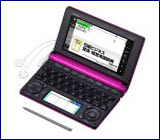





Facebook Comments
Don’t see the comments box? Log in to your Facebook account, give Facebook consent, then return to this page and refresh it.